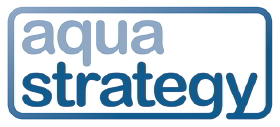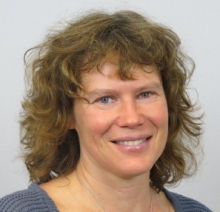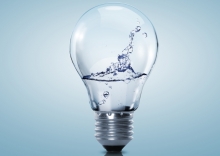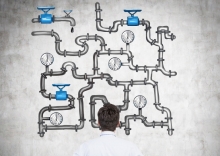Issue:
US water utility research organisation Water Environment & Reuse Foundation is supporting efforts to make practical progress in building smarter water utilities. Keith Hayward spoke with Walter Graf, who is leading its Intelligent Water Systems research challenge.

As a research organisation that runs projects with US water utilities, the Water Environment & Reuse Foundation gets real insight into the status of the industry. One of the insights comes from feedback its project investigators get from Chief Information Officers of some of the largest water and wastewater utilities in the country. ‘They say that only about 10% of the data they generate is really used,’ says Walter Graf, Program Director – Strategic Asset Management and Intelligent Water Systems.
One reason why 90% is not used is down to a lack of tools, especially where data is held in the various silos across a utility created by different software platforms being used for different purposes. ‘Lots of times they don’t communicate with each other, so it is extremely difficult to be able to take financial data from one piece of software and try to match it up with asset management or customer software,’ says Graf, by way of example. ‘One of these days I’m hoping there’s going to be some kind of system where all of a sudden we can get these different operating systems to start communicating with each other,’ he adds.
The other key reason is to do with staffing. ‘As utilities move towards being more digitally based for how they do a lot of their business, the staffing has not caught up with that yet,’ says Graf. This means a need for roles such as data scientists, engineers and analysts, and perhaps a chief data officer. ‘It is not like these utilities don’t know it is an issue, they just have not been able to get their arms around it yet,’ he adds.
If these barriers can be overcome, it ultimately means there is the potential for utilities to make different and better informed decisions. ‘90% is not used, and there is a lot of value in that,’ says Graf. He explains that this has actually been tested by utilities revisiting earlier decisions. ‘We have some examples where utilities have gone back and examined decisions they made five or ten years ago based on the knowledge they had at the time about their capital improvement programme,’ he says. They have been able to analyse the data with the better tools available now, and have adjusted their programmes in light of this.
Dealing with data
Such issues are the focus of WE&RF’s Intelligent Water Systems research challenge. One of the projects that are currently being undertaking to move forward in this area is called ‘Leveraging big data’. Graf explains that involves looking at how industries such as retailers, financial firms, and possibly IoT firms and power utilities work with the large amounts of data they generate. ‘We are trying to pick some tips up and learn from others, so we don’t have to start from scratch,’ says Graf.
Another is ‘Designing sensor networks on an urban sewershed scale’. WE&RF has previously compiled a worldwide compendium of sensors. The emphasis now is to focus on what it is sensors do. ‘They give us data, which we can transform into information,’ says Graf. The sewershed project will look at aspects of sensor network design such as where sensors are placed, where data processing takes place, and the need to factor in rainfall for networks combined sewers.
While most data currently goes unused, this does not necessarily mean that more data is in itself a good thing. ‘One of the things we want to look at is to see what data is actually useful to our subscribers or the water sector,’ says Graf. He notes, for example, the potential for flow meters to give readings every few seconds, but contrasts this with a customer perhaps only wanting to know each month how much water they have used. ‘Sensors can throw off all different types of data, and sometimes these data are just add-ons that are not really used for anything,’ he adds.
Given the potential for sewer networks to be the source of large amounts of data, and the fact that other sectors are already engaged with this data challenge, Graf anticipates that these two projects may well be merged. The aim then would be to carry out some pilots or demonstration projects at a small number of utilities and to look into data analytics as part of these.
Planning for a changing workforce
Graf is particularly enthusiastic about another of WE&RF’s projects – one that is focused on the workforce of the future. The digital revolution forms part of this picture, but the project is looking more broadly than this. It means looking at what skills utilities are likely to need over anything from five to 25 years, at megatrends such as the global economy, at the potential for radical new treatment technologies, and at future interaction with customers.
The project is based on surveys and workshops and is being carried out in partnership with the Water Services Association of Australia. The principal investigator is consultancy KPMG, which offers a presence in both Australia and the US. It is a relatively short project which began in March, with the US workshop being held in July.
Graf comments that he was in contact with utility managers as part of the preparations for the US workshop. ‘Every one of them said the workforce was their number one priority. They realise that, but they also have some real difficulties trying to figure out exactly what they need,’ he says.
Wider efforts to progress utilities
Other projects WE&RF is carrying out include one focused on the reliability of potable reuse. WE&RF was created last year by a merger of the Water Environment Research Foundation and the WateReuse Research Foundation. This project was originally a WateReuse Research Foundation project and is approximately three quarters complete.
Another project is developing an improvement methodology for utilities. This has been running for around six months, with another year and a half to go, and aims to provide utilities with a software-based system through which they can put their business processes into a model and be guided as to the steps needed to take each business process forward. Graf believes this type of contribution is crucial to the evolution of utilities. ‘My background in the wastewater industry is in asset management, so I’m completely convinced that management is the way that we work through this,’ he says.
Collaboration is also key, especially given the considerable professional separation in the US between the water supply and wastewater parts of the sector. ‘You can’t really do one half of the equation, for several reasons,’ says Graf. ‘One, it is just inefficient. Two, we have utility subscribers that have drinking water and wastewater and reuse.’
This means, for example, that WE&RF works jointly on projects with the Water Research Foundation, which is focused on drinking water. He points also to the collaboration with WSAA in Australia, which covers both sides of the sector. Such collaboration makes the most of the available funding, with wider benefits too. Graf recalls that the respective organisations attended each other’s events in 2015, for example. ‘Not only did we all know exactly what the others were doing, but we were contributing to each organisation’s priorities and project plans,’ he says.
Several of the projects span the interests of the sector in any case. Regarding the on-going business process project, Graf notes: ‘This is a WE&RF-driven project, but we didn’t turn away anyone that wanted to participate in it. A lot of these [business] decisions are similar.’ The same applies as far as the workforce project is concerned. ‘That’s agnostic as far as what part of the sector we are dealing with, and purposely so,’ he adds.
The future is digital
There are exciting prospects ahead for the industry. Graf points to areas such as the potential for new treatment technologies to transform utilities. He says that a current project is looking at a treatment process which produces oil from wastewater, at the same time eliminating the need for biosolids disposal. ‘That has the potential to be a real game-changer in the utility industry,’ he says.
Linked in part to this, changes such as the move towards wastewater utilities becoming energy neutral or even energy positive may open up new business opportunities to utilities, potentially selling oil, gas or power.
The digital transformation features prominently in this future view. This could mean that utilities decide they would rather not process certain types of data themselves and so send it off site. Equally, Graf sees that utilities are starting to look into offering consulting services in different areas of expertise and that data is one potential area for them to do this. ‘A utility may think they are really good at dealing with data and start offering to do data services for other utilities,’ he says, adding: ‘There are a lot of possibilities with the business model.’
Data is also likely to support a change in interaction with customers, both of providing the customer with greater information about their own water and wastewater and about the activities of the utility and any work on the network, for example. ‘We think there is going to be a lot more customer involvement interacting with the utility,’ says Graf.
A further change is illustrated by a project Graf says WE&RF is looking at. This would collect data on wastewater pipes and store it in a central secure database. Utilities and others could then access this data to support modelling of their networks to look at aspects such as remaining pipe life. Graf says that work is underway in the water sector, and that the wastewater work would be a ‘massive’ big data project. ‘One advantage is that, if you don’t have enough data to model, you can find data for similar conditions and use that as a proxy as you attempt to model your own system,’ he says.
Given all these opportunities, what do these mean for the utility of the future? ‘For one thing, the future utility will be what we are referring to as the digital utility,’ concludes Graf.
Keywords:
- USA, Australia, smart utilities






